2003 FORD SUPER DUTY air condition
[x] Cancel search: air conditionPage 6 of 56
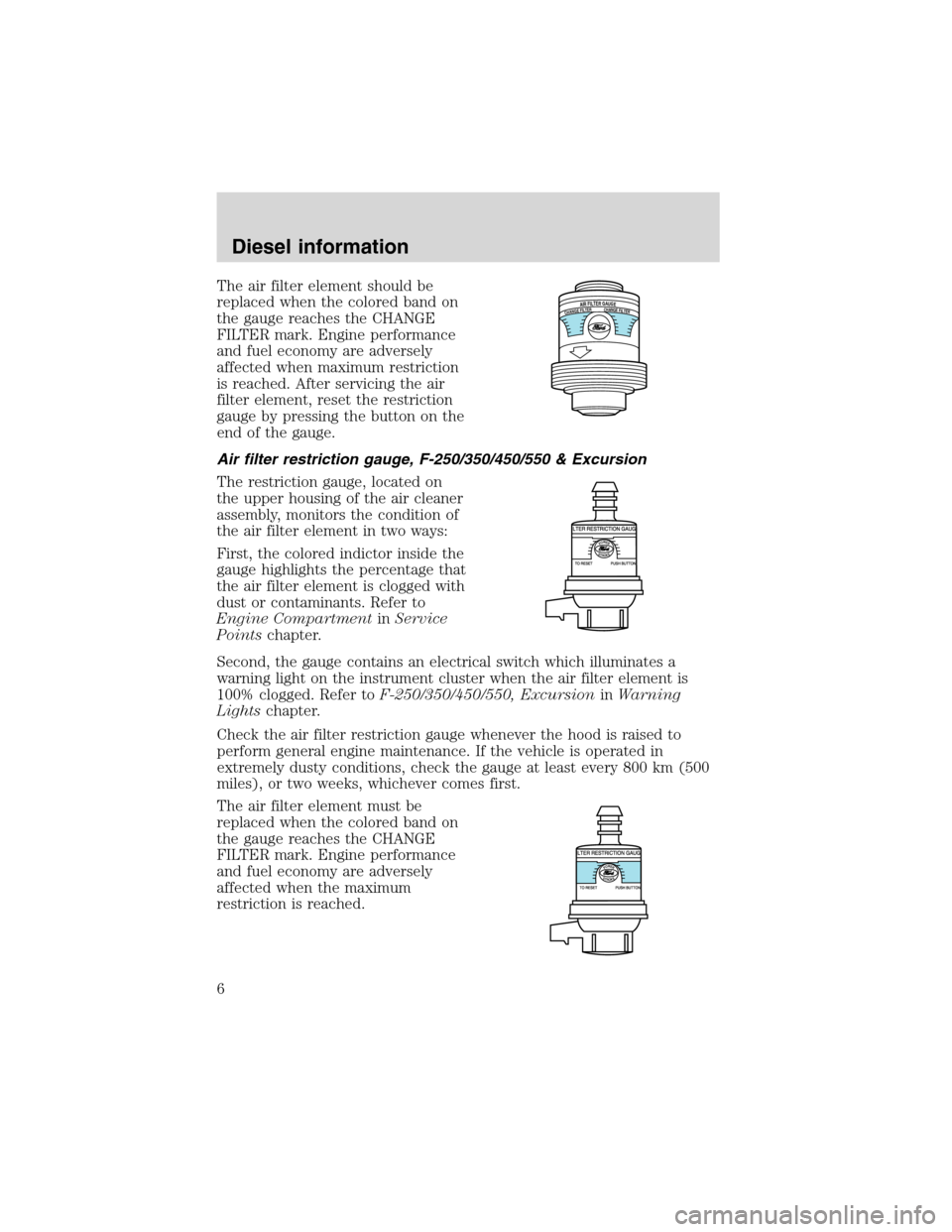
The air filter element should be
replaced when the colored band on
the gauge reaches the CHANGE
FILTER mark. Engine performance
and fuel economy are adversely
affected when maximum restriction
is reached. After servicing the air
filter element, reset the restriction
gauge by pressing the button on the
end of the gauge.
Air filter restriction gauge, F-250/350/450/550 & Excursion
The restriction gauge, located on
the upper housing of the air cleaner
assembly, monitors the condition of
the air filter element in two ways:
First, the colored indictor inside the
gauge highlights the percentage that
the air filter element is clogged with
dust or contaminants. Refer to
Engine CompartmentinService
Pointschapter.
Second, the gauge contains an electrical switch which illuminates a
warning light on the instrument cluster when the air filter element is
100% clogged. Refer toF-250/350/450/550, ExcursioninWarning
Lightschapter.
Check the air filter restriction gauge whenever the hood is raised to
perform general engine maintenance. If the vehicle is operated in
extremely dusty conditions, check the gauge at least every 800 km (500
miles), or two weeks, whichever comes first.
The air filter element must be
replaced when the colored band on
the gauge reaches the CHANGE
FILTER mark. Engine performance
and fuel economy are adversely
affected when the maximum
restriction is reached.
AIRFILTERGAUGECHANGEFILTERCHANGEFILTER
Diesel information
6
Page 7 of 56
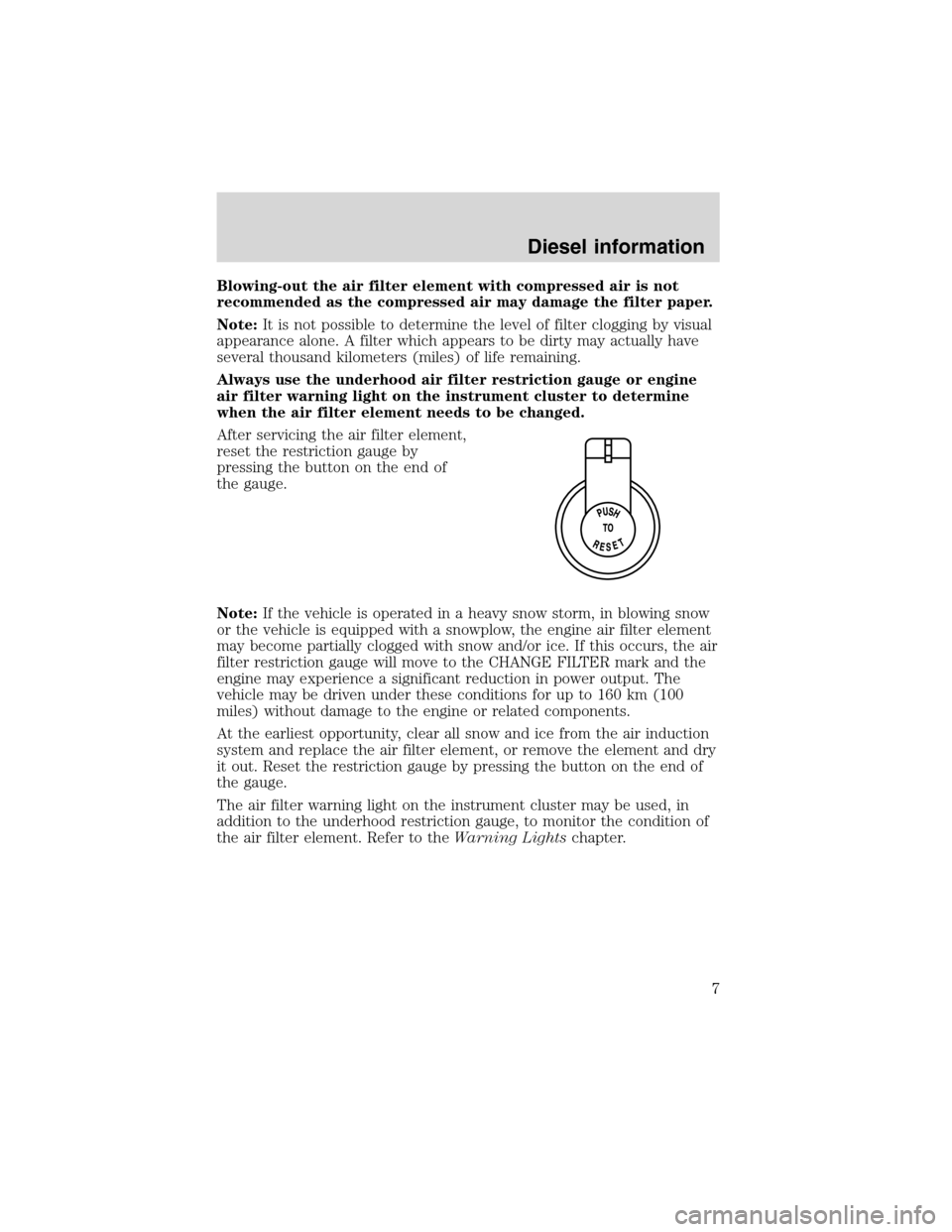
Blowing-out the air filter element with compressed air is not
recommended as the compressed air may damage the filter paper.
Note:It is not possible to determine the level of filter clogging by visual
appearance alone. A filter which appears to be dirty may actually have
several thousand kilometers (miles) of life remaining.
Always use the underhood air filter restriction gauge or engine
air filter warning light on the instrument cluster to determine
when the air filter element needs to be changed.
After servicing the air filter element,
reset the restriction gauge by
pressing the button on the end of
the gauge.
Note:If the vehicle is operated in a heavy snow storm, in blowing snow
or the vehicle is equipped with a snowplow, the engine air filter element
may become partially clogged with snow and/or ice. If this occurs, the air
filter restriction gauge will move to the CHANGE FILTER mark and the
engine may experience a significant reduction in power output. The
vehicle may be driven under these conditions for up to 160 km (100
miles) without damage to the engine or related components.
At the earliest opportunity, clear all snow and ice from the air induction
system and replace the air filter element, or remove the element and dry
it out. Reset the restriction gauge by pressing the button on the end of
the gauge.
The air filter warning light on the instrument cluster may be used, in
addition to the underhood restriction gauge, to monitor the condition of
the air filter element. Refer to theWarning Lightschapter.
Diesel information
7
Page 11 of 56

4. When the engine starts, release the key. The glow plugs will continue
to be activated for up to two minutes. If the engine is not started before
the activation ceases, the glow plug system must be reset by turning the
ignition key to OFF.
5. After the engine starts, allow it to idle for about 15 seconds. (Do not
increase engine speed until the oil pressure gauge indicates normal
pressure.)
STOPPING THE ENGINE
Turn the ignition to OFF. To prolong engine life (after extended high
speed or maximum GVW operation), it is recommended that a hot engine
be allowed to operate at low idle for about 7–10 minutes which would
allow sufficient time for the turbocharged engine to cool down.
COLD WEATHER OPERATION
Changing to a lighter grade engine oil also makes starting easier under
these conditions. Refer toEngine Oil Specificationsin theGeneral
maintenance informationchapter.
At temperatures below–7°C (20°F), Number 2–D Diesel fuel may
thicken enough to clog the fuel filter. Your engine is equipped with a fuel
filter/heater/water/separator to keep the wax melted which will help
prevent fuel filter clogging. However, if the engine starts but stalls after a
short time and will not restart, the fuel filter may be clogged. For best
results in cold weather, use Number 1–D Diesel fuel or“winterized”
Number 2–D Diesel fuel which has an additive to minimize wax
formation.
Your vehicle is also equipped with a bypass relief valve, located on the
in-tank fuel sending unit, which provides fuel flow to the engine if the
fuel pickup should become plugged by ice or wax. To allow this bypass
valve to function and avoid engine fuel starvation, it is recommended
that, during cold weather operation 0°C (32°F) or below, the fuel level in
your tank should not be allowed to drop below 1/4 full. This will help
prevent air from entering the fuel system and stalling the engine.
In cold weather below 0°C (32°F) your Diesel engine will slowly increase
to a higher idle speed if left idling in P (Park). The sound of the engine
may change also, as an exhaust device engages to improve heater
performance and reduce exhaust smoke.
Starting
11
Page 33 of 56
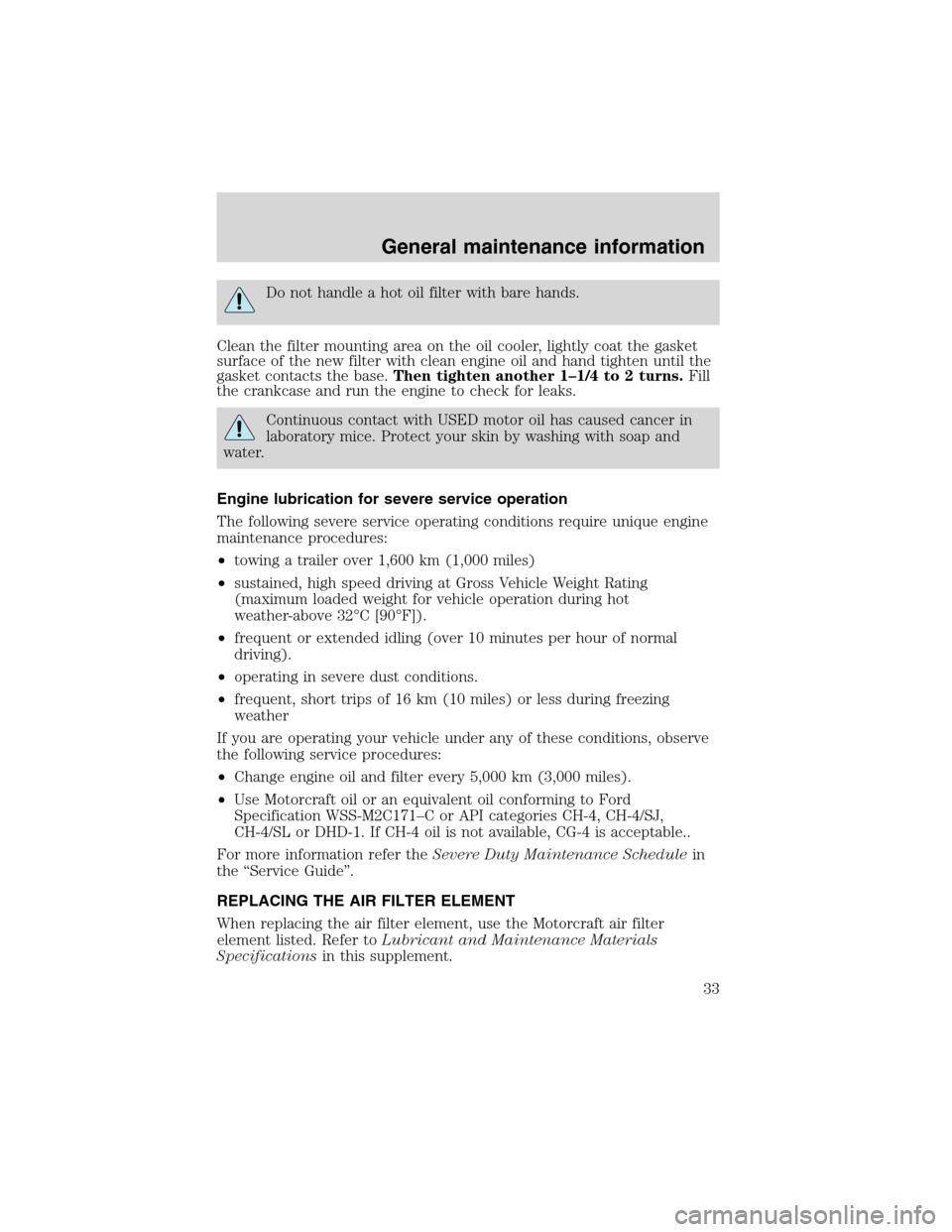
Do not handle a hot oil filter with bare hands.
Clean the filter mounting area on the oil cooler, lightly coat the gasket
surface of the new filter with clean engine oil and hand tighten until the
gasket contacts the base.Then tighten another 1–1/4 to 2 turns.Fill
the crankcase and run the engine to check for leaks.
Continuous contact with USED motor oil has caused cancer in
laboratory mice. Protect your skin by washing with soap and
water.
Engine lubrication for severe service operation
The following severe service operating conditions require unique engine
maintenance procedures:
•towing a trailer over 1,600 km (1,000 miles)
•sustained, high speed driving at Gross Vehicle Weight Rating
(maximum loaded weight for vehicle operation during hot
weather-above 32°C [90°F]).
•frequent or extended idling (over 10 minutes per hour of normal
driving).
•operating in severe dust conditions.
•frequent, short trips of 16 km (10 miles) or less during freezing
weather
If you are operating your vehicle under any of these conditions, observe
the following service procedures:
•Change engine oil and filter every 5,000 km (3,000 miles).
•Use Motorcraft oil or an equivalent oil conforming to Ford
Specification WSS-M2C171–C or API categories CH-4, CH-4/SJ,
CH-4/SL or DHD-1. If CH-4 oil is not available, CG-4 is acceptable..
For more information refer theSevere Duty Maintenance Schedulein
the“Service Guide”.
REPLACING THE AIR FILTER ELEMENT
When replacing the air filter element, use the Motorcraft air filter
element listed. Refer toLubricant and Maintenance Materials
Specificationsin this supplement.
General maintenance information
33
Page 34 of 56
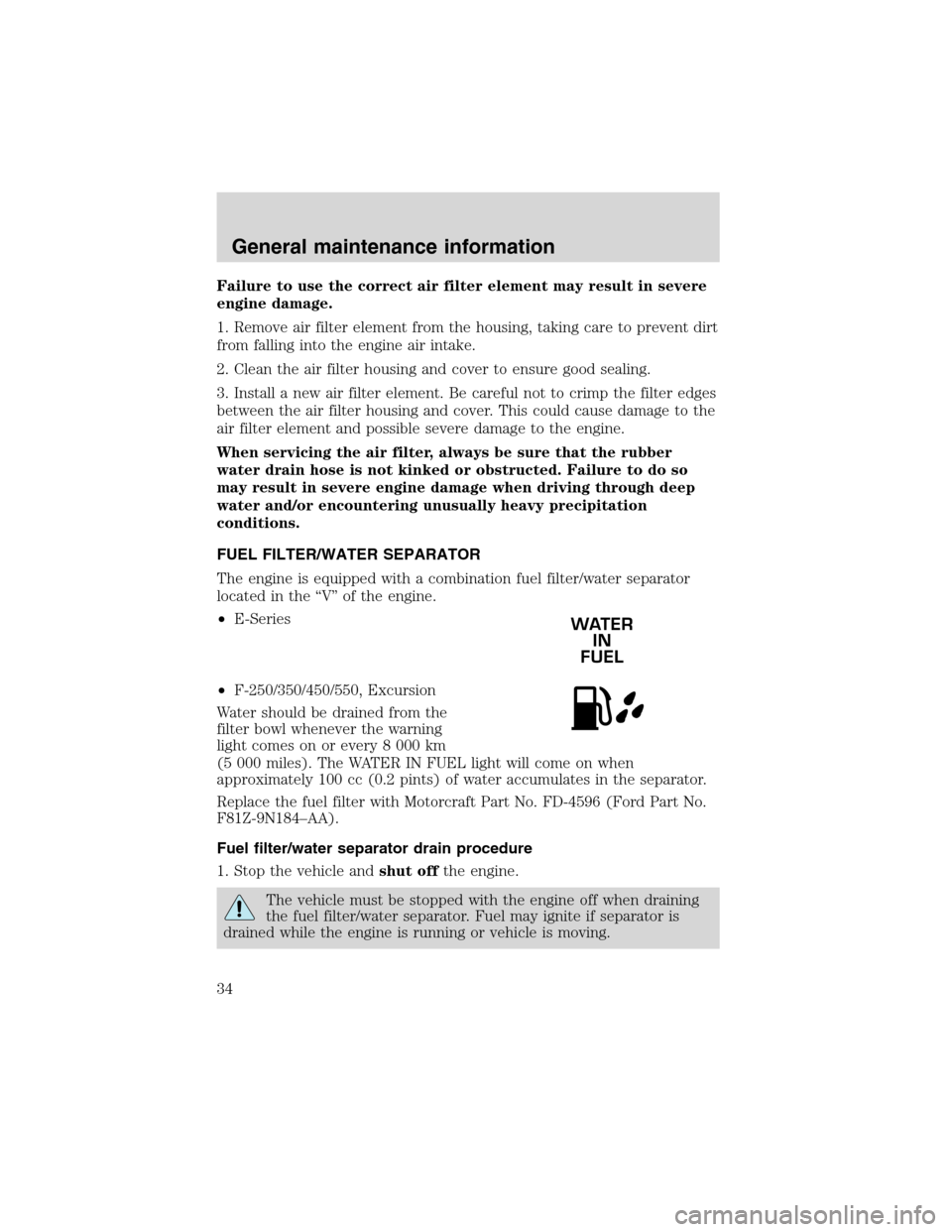
Failure to use the correct air filter element may result in severe
engine damage.
1. Remove air filter element from the housing, taking care to prevent dirt
from falling into the engine air intake.
2. Clean the air filter housing and cover to ensure good sealing.
3. Install a new air filter element. Be careful not to crimp the filter edges
between the air filter housing and cover. This could cause damage to the
air filter element and possible severe damage to the engine.
When servicing the air filter, always be sure that the rubber
water drain hose is not kinked or obstructed. Failure to do so
may result in severe engine damage when driving through deep
water and/or encountering unusually heavy precipitation
conditions.
FUEL FILTER/WATER SEPARATOR
The engine is equipped with a combination fuel filter/water separator
located in the“V”of the engine.
•E-Series
•F-250/350/450/550, Excursion
Water should be drained from the
filter bowl whenever the warning
light comes on or every 8 000 km
(5 000 miles). The WATER IN FUEL light will come on when
approximately 100 cc (0.2 pints) of water accumulates in the separator.
Replace the fuel filter with Motorcraft Part No. FD-4596 (Ford Part No.
F81Z-9N184–AA).
Fuel filter/water separator drain procedure
1. Stop the vehicle andshut offthe engine.
The vehicle must be stopped with the engine off when draining
the fuel filter/water separator. Fuel may ignite if separator is
drained while the engine is running or vehicle is moving.
General maintenance information
34
Page 42 of 56
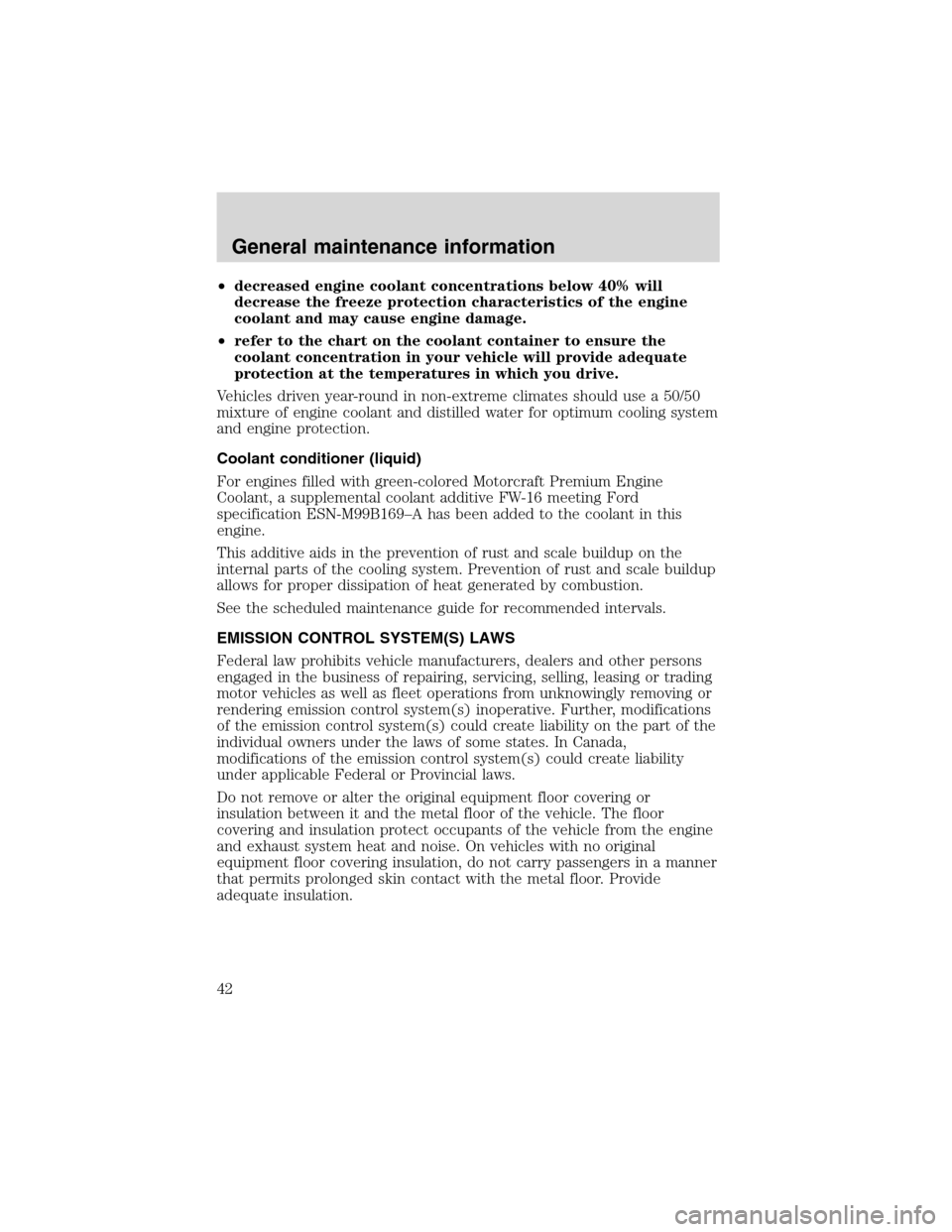
•decreased engine coolant concentrations below 40% will
decrease the freeze protection characteristics of the engine
coolant and may cause engine damage.
•refer to the chart on the coolant container to ensure the
coolant concentration in your vehicle will provide adequate
protection at the temperatures in which you drive.
Vehicles driven year-round in non-extreme climates should use a 50/50
mixture of engine coolant and distilled water for optimum cooling system
and engine protection.
Coolant conditioner (liquid)
For engines filled with green-colored Motorcraft Premium Engine
Coolant, a supplemental coolant additive FW-16 meeting Ford
specification ESN-M99B169–A has been added to the coolant in this
engine.
This additive aids in the prevention of rust and scale buildup on the
internal parts of the cooling system. Prevention of rust and scale buildup
allows for proper dissipation of heat generated by combustion.
See the scheduled maintenance guide for recommended intervals.
EMISSION CONTROL SYSTEM(S) LAWS
Federal law prohibits vehicle manufacturers, dealers and other persons
engaged in the business of repairing, servicing, selling, leasing or trading
motor vehicles as well as fleet operations from unknowingly removing or
rendering emission control system(s) inoperative. Further, modifications
of the emission control system(s) could create liability on the part of the
individual owners under the laws of some states. In Canada,
modifications of the emission control system(s) could create liability
under applicable Federal or Provincial laws.
Do not remove or alter the original equipment floor covering or
insulation between it and the metal floor of the vehicle. The floor
covering and insulation protect occupants of the vehicle from the engine
and exhaust system heat and noise. On vehicles with no original
equipment floor covering insulation, do not carry passengers in a manner
that permits prolonged skin contact with the metal floor. Provide
adequate insulation.
General maintenance information
42
Page 45 of 56
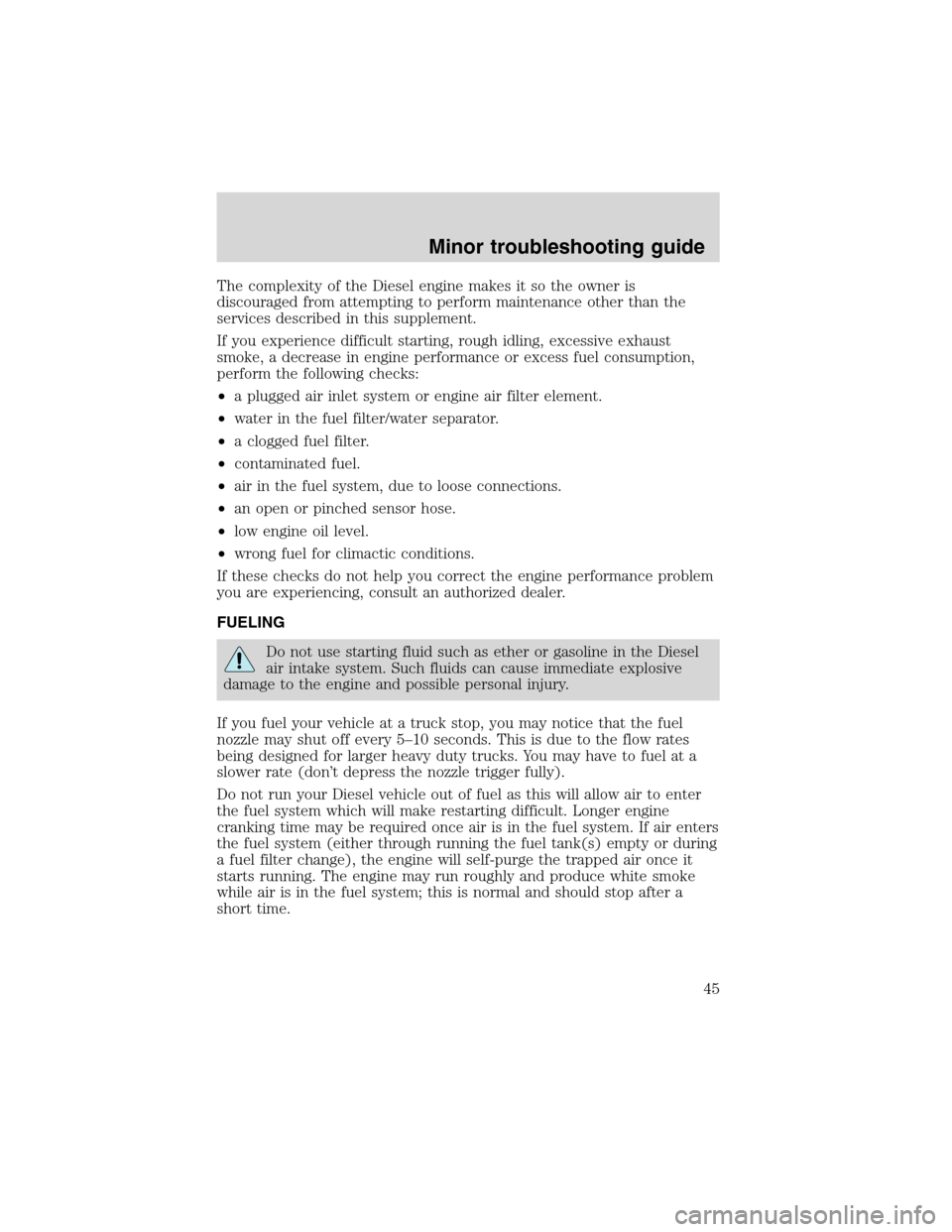
The complexity of the Diesel engine makes it so the owner is
discouraged from attempting to perform maintenance other than the
services described in this supplement.
If you experience difficult starting, rough idling, excessive exhaust
smoke, a decrease in engine performance or excess fuel consumption,
perform the following checks:
•a plugged air inlet system or engine air filter element.
•water in the fuel filter/water separator.
•a clogged fuel filter.
•contaminated fuel.
•air in the fuel system, due to loose connections.
•an open or pinched sensor hose.
•low engine oil level.
•wrong fuel for climactic conditions.
If these checks do not help you correct the engine performance problem
you are experiencing, consult an authorized dealer.
FUELING
Do not use starting fluid such as ether or gasoline in the Diesel
air intake system. Such fluids can cause immediate explosive
damage to the engine and possible personal injury.
If you fuel your vehicle at a truck stop, you may notice that the fuel
nozzle may shut off every 5–10 seconds. This is due to the flow rates
being designed for larger heavy duty trucks. You may have to fuel at a
slower rate (don’t depress the nozzle trigger fully).
Do not run your Diesel vehicle out of fuel as this will allow air to enter
the fuel system which will make restarting difficult. Longer engine
cranking time may be required once air is in the fuel system. If air enters
the fuel system (either through running the fuel tank(s) empty or during
a fuel filter change), the engine will self-purge the trapped air once it
starts running. The engine may run roughly and produce white smoke
while air is in the fuel system; this is normal and should stop after a
short time.
Minor troubleshooting guide
45